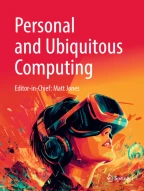Abstract
Virtualization technology is playing an important role in cloud computing for efficient task scheduling and application deployment. Cloud computing offers a platform to store and retrieve a large volume of information without any restriction on time or location. The system optimizes the available resource based on the user application requirement. Server and data storage devices can access distributed data residing in remote places via virtualization mechanism, where cloud applications are easily migrated from one server to another. Issues related to fault identification and resource optimization problems often occur in a cloud environment. To resolve these issues, an enhanced fault identification and optimal task prediction (EFIOTP) algorithm are proposed for finding and preventing faults during task execution with multiple resources. The research work objective is to design a deadline-determined resource allocation model with the VM resource isolation method in a cloud. The proposed work evaluates the maximum amount of task execution by considering different types of resources to identify and predict the faults at various levels and to minimize the occurrence of faults and task execution time. Based on the experiment evaluation, the proposed EFIOTP algorithm reduces 775 task completions (TCT), 0.237 datacenter server utilization (DCSU), 2% virtual machine cost (VMC), and improves the 0.39 hypervolumes (HV) on several parameters and scientific workflow application.
Similar content being viewed by others
References
Sandeep M, Harsh KV, Sangal AL (2017) Simulation modelling of cloud computing for smart grid using CloudSim. J Electr Syst Inf Technol 4(1):159–172
Mohamed AE, Hosam ER (2017) A proposed fault tolerance model for cloud system based on the distributed shared memory. Egypt Comput Sci J 41(1):1110–2586
Alim UG, Rayhanur R, Asif I, Kazi S (2013) The performance evaluation of proactive fault-tolerant scheme over cloud using CloudSim simulator.Int J Web Appl 5(4):176–186
Ghamdan MQ, Madhu BK (2017) Proactive fault tolerance in cloud data centers for performance efficiency. Int J Pure Appl Math 117(22):325–329
William V, Rajkumar B (2012) Reliable provisioning of spot instances for compute-intensive applications. In 2012 IEEE 26th International Conference on Advanced Information Networking and Applications, pp 542–549
Kalanirnika GR, Sivagami VM (2015) Fault tolerance in cloud using reactive and proactive techniques. Int J Comput Sci Eng Commun 3(3):1159–1164
Padmakumari P, Umamakeswari A, Akshaya M (2016) Hybrid fault-tolerant scheme to manage VM failure in the cloud. Indian J Sci Technol 9(48):1–5
Indirani S, Jothi VC (2016) Implementation of LMMC and SBA algorithms in cloud infrastructure using Cloudsim. Int J Control Theory Appl 9(10):4285–4291
Marc B, Ulf L (2015) DynamicCloudSim: simulating heterogeneity in computational clouds. Futur Gener Comput Syst 46:85–99
Najuka S, Nikitha K, Nimisha SM (2014) Task scheduling for efficient resource utilization in cloud. A Project Report for course COEN 241, pp 1–25
Anusha B, Sharmini E (2017) Optimization of resource allocation parameters in cloud environment using design of experiments. Int J Pure Appl Math 116(22):217–232
Michael B, Stefan S, Christoph H (2016) Predicting cloud resource utilization,” 2016 IEEE/ACM 9th International Conference on Utility and Cloud Computing (UCC), Shanghai, pp 37–42
Manvi SS, Shyam GK (2014) Resource management for infrastructure as a service (IaaS) in cloud computing: a survey. J Netw Comput Appl 41:424–440
Rajkumar B, Kotagiri R, Chris L, Rodrigo N, Calheiros AVD, Steve V (2015) Big data analytics-enhanced cloud computing: challenges, architectural elements, and future directions. IEEE 21st International Conference on In Parallel and Distributed Systems (ICPADS), pp 75–84
Xu CZ, Rao J, Bu X (2012) URL: a unified reinforcement learning approach for autonomic cloud management. J Parallel Distrib Comput 72(2):95–105
Zhang Y, Zheng Z, Lyu MR (2011) Exploring latent features for memory-based QoS prediction in cloud computing. 2011 30th IEEE Symposium on In Reliable Distributed Systems (SRDS), pp 1–10
Wu JH (2015) Research of resource allocation in cloud computing based on improved dual bee colony algorithm. Int J Grid Distrib Comput 8(5):117–126
Calheiros RN, Ranjan R, Beloglazov A, De Rose CA, Buyya R (2010) CloudSim: a toolkit for modeling and simulation of cloud computing environments and evaluation of resource provisioning algorithms. Softw Pract Exp 41(1):23–50
Zheng Z, Zhou TC, Lyu MR, King I (2010) FTCloud: a component-ranking framework for fault-tolerant cloud applications. IEEE 21st International Symposium on Software Reliability Engineering (ISSRE), pp 398–407
Zheng Z, Lyu MR (2015) Selecting an optimal fault tolerance strategy for reliable service-oriented systems with local and global constraints. IEEE Trans Comput 64(1):219–232
Giorgio LV, Samee UK, Pascal B (2013) Energy-efficient resource utilization in cloud computing. Wiley, Hoboken, pp 1–34
Noha H, Amal EA, Nahla E, Mostafa-Sami MM (2017) Resource allocation strategies in cloud computing: overview. Int J Comput Appl 177(4):18–22
Zhang B, Sconyers C, Byington C, Patrick R, Orchard ME, Vachtsevanos G (2010) A probabilistic fault detection approach: application to bearing fault detection. IEEE Trans Ind Electron 58(5):2011–2018
Litke A, Skoutas D, Tserpes K, Varvarigou T (2007) Efficient task replication, and management for adaptive fault tolerance in mobile grid environments. Futur Gener Comput Syst 23(2):163–178
Anwar N, Deng H (2018) A hybrid metaheuristic for multi-objective scientific workflow scheduling in a cloud environment. Appl Sci 8(4):1–21
He G, Yang J, Behnke S (2018) Research on geometric features and point cloud properties for tree skeleton extraction. Pers Ubiquit Comput 22(5–6):903–910
Jin M, Wang H, Song L, Li, Zeng Y (2018) Man-machine dialogue system optimization based on cloud computing. Pers Ubiquit Comput 22(5–6):937–942
Chandra I, Prabha KH, Sivakumar N (2018) Optimization of QoS parameters using scheduling techniques in heterogeneous network. Pers Ubiquit Comput 22(5–6):943–950
Author information
Authors and Affiliations
Corresponding author
Additional information
Publisher’s note
Springer Nature remains neutral with regard to jurisdictional claims in published maps and institutional affiliations.
Rights and permissions
About this article
Cite this article
Nandhini, J.M., Gnanasekaran, T. Enhanced fault identification and optimal task prediction (EFIOTP) algorithm during multi-resource utilization in cloud-based knowledge and personal computing. Pers Ubiquit Comput 26, 285–295 (2022). https://doi.org/10.1007/s00779-019-01265-6
Received:
Accepted:
Published:
Issue Date:
DOI: https://doi.org/10.1007/s00779-019-01265-6
